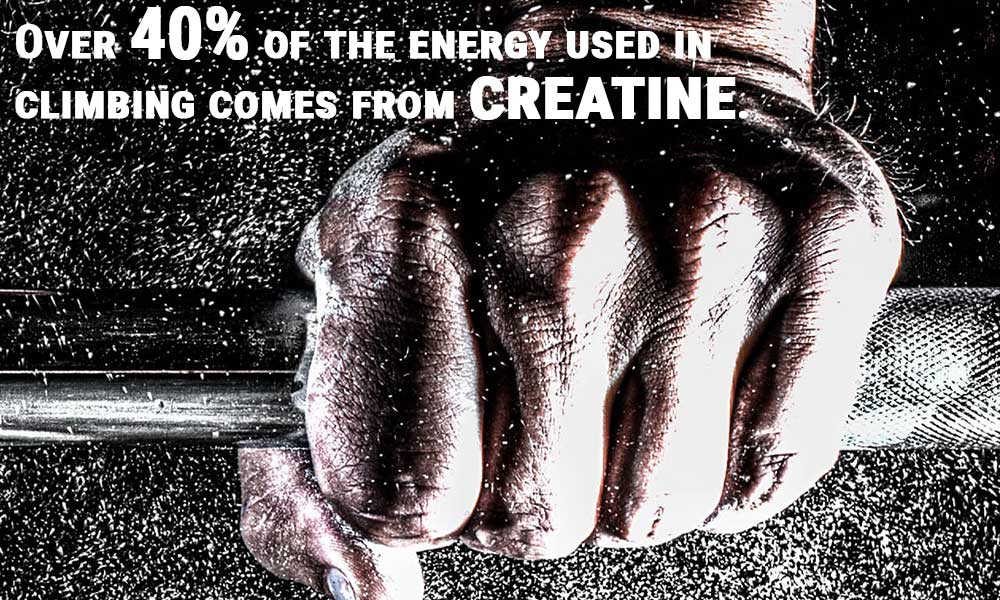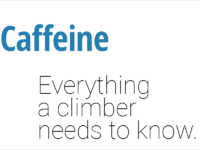I haven’t written an official supplement guide for creatine yet—believe me, it’s on my to-do list—but I wanted to “prime” my readers to one of the reasons why creatine is potentially such a helpful supplement.
Creatine, if you did not know, is used in one of our body’s primary energy systems. The phosphagen system (or creatine phosphate system) is our body’s absolute quickest way to produce cellular energy (ATP) in response to sudden demand—it has almost double the capacity for ATP regeneration as its nearest competitor (anaerobic glycosis—turning glucose into lactate), and eight times the capacity for ATP regeneration as burning fat. Essentially what this means is that creatine has the proverbial muscle to power exercise of the absolute highest intensities; no other energy system is nearly as capable.
The downside is that creatine is also our body’s most limited energy system, and we only have a few seconds worth depending on how intense our exercise is. Assuming you’re climbing something at or near your limit, you’ll be lucky if you get more than 5-10 seconds worth of energy at a time from creatine before it needs to be regenerated. That means 5-10 seconds of maximum exertion before you run out, decreasing your power output and potentially causing you to fail. Thankfully, all it takes to regenerate creatine to creatine phosphate is a little oxygen (as will be discussed further shortly)
The only study that has been done that looked at which energy systems fuel (indoor) climbing found that creatine supplied roughly 42.4% of the total energy across an 82-second climb. In recreational climbers doing an easy climb, creatine supplied 41.5% of the total energy. From this study, it appears that creatine in general pretty consistently supplies about 40% of the energy used for climbing.
If we examine the question in a different way, though, we might get an even greater figure for how much energy creatine supplies during a typical climb. This is because the study authors hypothesized that the other major energy contributor—the aerobic system—mostly “contributed” by providing the energy necessary to regenerate spent creatine into creatine phosphate whenever oxygen was available. In other words, creatine provides the oomph necessary to power up the wall, and whenever your muscles relax (such as during a rest or really whenever you let go of a hold before you grab the next one) and there is oxygen available your aerobic system recharges the creatine for another go.
So creatine is pretty important for the average climber (and the elite climber, and the beginner climber). And unlike the other energy systems, which you cannot really affect, you can significantly increase the availability of your creatine phosphate system! In fact, you can increase your reserves of creatine phosphate by 33% with creatine supplementation, thereby increasing your reserves of this über-important molecule and quite likely your power endurance as well.
This benefit is really just the tip of the iceberg, though—it’s the obvious one, the one we’d expect to see regardless of whatever else is true. When I do finally get around to the official guide page on creatine, you’ll see there are a lot more reasons to consider creatine supplementation, and also that the reasons you probably think you shouldn’t use it are bogus. In the meantime, I hope this “primer” helped.















How does this figure into the postworkout recovery requirements for protein? what do you recommend concerning this?
Protein requirements aren’t affected by creatine, so they remain the same. There’s no particular need to get protein directly after a workout so long as you’re getting enough throughout the day, but it’s often convenient to plan meals for after a workout (particularly if it’s a long workout), so chances are you’ll get protein within an hour or two anyhow. With creatine, it may be better to take one dose after a workout, especially during the initial loading week, but if examined over enough time I suspect there’s probably not a distinct advantage there, either.
Great article, thank you for the information. How would you advise combating the ‘pump’ that creatine gives during muscle exertion, surely this can be detrimental to climbing?
Creatine will actually help prevent the adverse effects of the pump, but it helps to first deconstruct what is happening when a climber gets pumped. From our perspective, it feels like our forearms swell and subsequent to that we begin to feel the burning sensation of fatigue; it appears as if one leads to the other. They are, in fact, related, but the swelling is actually a preventative measure our body takes to prevent fatigue—it’s the result of increased blood flow (i.e., oxygenation) to the muscles. Even that’s just a stopgap measure, though, as eventually our muscles will fatigue regardless, at least in most climbing scenarios.
Creatine enters the picture in two ways: first, it increases muscle relaxation velocity; second, it buffers against accumulating H+ build-up. The former helps our muscles relax and become more easily reoxygenated during rests (or any time we release a hold). The latter helps by giving us a bit more time before H+ builds to a critical level and triggers fatigue. In these ways, creatine is more likely to combat the pump—or at least the fatiguing aspects of the pump—than contribute to it.
It’s a bit of a toss-up whether the muscle swelling creatine can occasionally cause would be beneficial (because of increased oxygenation), detrimental (because of increased pressure and subsequent decreased oxygenation, or neutral. My educated guess would be mostly neutral, perhaps slightly positive, as creatine would only cause increased swelling in a couple ways, either through increased muscle water content or increased vascular dilation. Vascular dilation would be good, and slightly increased muscle water content is unlikely to cause enough extra pressure to do anything meaningful towards our performance.
I don’t know if you’ve checked this article out, but I wrote a longer and more in-depth guide to creatine that might answer other concerns you have!
Eric Hörst writes that although creatine works the way you describe above, the problem with using creatine supplements for climbing is this: they make the ENTIRE body hold more water than normal, not just the forearms, which can result in an overal weight gain that outweighs the benefits of the extra creatine available in the forearm muscles.
What are your thoughts on this? You could argue that the performance gains in other muscles than the forearms would outweigh the negative effects from the weight gains, but I don’t think they would… The forearms and fingers are still by far the most important factor in performance i.m.o – I don’t know a single climber that needs extra strong and bulky legs…
Keen to hear what you think! Great site btw, really enjoy your writing and articles. Keep it up.
You will gain water throughout the body, but it’s a bit more complicated than simply being an even spread. The reason you gain water weight is because creatine is stored along with water, so for every gram of creatine stored you also store 2-3 grams of water. You’ll store creatine in a muscle in greater or lesser quantities depending on a couple factors: first, what type of muscle it is (i.e., Type I [Slow-Twitch], Type IIx [Fast-Twitch], Type IIa [Intermediate Fast-Twitch]), and how much that muscle is used. The more reliant on anaerobic energy systems a muscle is—that is, the more Type IIx and IIa fibers it has—the more creatine it will store, and vice-versa. Broadly speaking, our legs are dominated by Type I fibers as their primary functions are all endurance based. Our upper body, on the other hand, is dominated by Type II fibers (of both types) because most upper-body heavy activities are more power-oriented. As climbers, most of us work (and thus develop) our upper body to a greater extent than our lower body as well. Thus, we might expect more creatine to wind up in the upper body, though the leg muscles are very large and so we would certainly gain some weight there as well. The forearms, being very small muscles even in the strongest climbers, will not gain much weight from creatine compared to the larger back, shoulder, and upper arm muscles.
It would be nice to see some data—have a study funded—that actually measures the change in performance for climbers when taking creatine, because right now I am just extrapolating from data in other sports. To me, that data clearly demonstrates the advantages of creatine, and the small gain in weight seems unlikely to counter those benefits for most climbers in most situations. It’s not just a gain in power, it’s also a gain in short-term recovery speed and buffering capacity, all of which make a huge difference to climbers both during and between climbs. But, I can’t confirm those benefits outweigh the weight gain, only suggest they probably do—at least until we do that study!